by Winding Pathways | Jan 5, 2022 | (Sub)Urban Homesteading, Flowers/Grasses, Garden/Yard, Garden/Yard, Nature
A raging blizzard roaring over Winding Pathways just before Christmas 2022 showed us the power of HARVESTING SNOW. We love catching it. Other parts of the country endure blizzards, especially Nor’ Easters
Well, we didn’t really catch the snow, but our prairie did. It has a talent for harvesting snow and other forms of moisture. It taught us how prairie and other taller plants – grasses, forbs, shrubs, vines, and trees – help themselves grow next summer.
Our prairie has a thick growth of two-foot-tall dead stems from last summer’s growth. Each stalk is brittle, but thousands of them working together slowed the wind just enough for it to drop the snow it had swept off nearby lawns and roads.
The deep drift that settled on our prairie will melt and give next spring’s plants a jumpstart in moist soil. Nearby shortly sheared lawns can’t catch snow and will start the spring on dryer soil. Nature delivered irrigation water to our yard for free!
Sharing Nature’s Wisdom
In dry regions of the country, snow also helps next summer’s vegetables. During college, Rich worked weekends at an Idaho ranch. He was surprised one January when Lucille Pratt, part owner of the land and an outstanding vegetable gardener, asked him to shovel a snow drift from nearby onto the garden.
For a Jersey boy, this seemed like a weird request. He did as asked and learned that melting snow oozed water into the soil. That helped get the vegetables going come spring and sustained them through the dry north Idaho summers.
Snow may be a bother to some, but it’s also a blessing to dry soil and the plants it sustains.
Over two blizzardy days, our prairie gently caught snowflake after snowflake. We already are looking forward to bright prairie flowers dancing in next summer’s breeze. Thanks, prairie for harvesting snow. Nature’s wisdom to catch winter’s snow and help next summer’s growth is amazing.
-
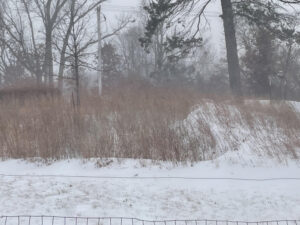
-
Capturing snow.
-
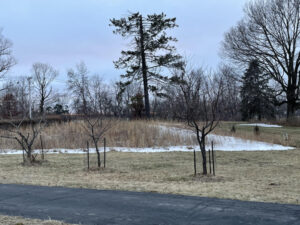
-
Three days later, a rapid melt left the ground bare, except where prairie plants held snow.
by Winding Pathways | Nov 11, 2021 | (Sub)Urban Homesteading, Birds, Garden/Yard, Nature
“A woodpecker is hammering on my house. It’s damaging my siding and driving me nuts. What can I do?” asked a longtime friend.
Woodpeckers often hammer on buildings, and we’ve taken dozens of calls from homeowners seeking relief. There are ways to discourage the plucky birds.
Woodpeckers bang on wood for at least three reasons:
- Drumming. Drumming on wood or metal in a rapid burst announces the bird’s presence to others. It is loud advertising.
- Nesting. Woodpeckers excavate cavities, usually in dead trees, to make a safe comfortable nest in the spring. A snug nest within an insulated wall is a great substitute for a tree.
- Food. Woodpeckers make their living dining on insects lurking in wood. Commonly this is a fall and winter activity, especially on home sided with rustic
T 111 plywood.
We love woodpeckers, and so do most people. But, no one wants damage to their home. So, how can it be prevented?
Prevention
It’s tough to stop drumming, but the good news is that it is usually of short duration in the spring and rarely damages the home.
It is difficult to stop birds from excavating a nest, but fortunately this is relatively rare. The long-term solution is to side the home with a durable hard material. Bricks are ideal.
Foraging may be the most common home damage. It can be extensive and comes with annoying noise as the bird removes wood to expose hidden bugs. Here are some solutions:
If building a new home, specify siding that lacks holes and cracks. If no insects can enter woodpeckers have no reason to try to extract them.
- With a caulking gun and putty knife plug every possible hole in the home’s exterior in late winter or early spring. This prevents insects from entering.
- If a woodpecker is foraging on a small section of the house draping light duty netting, the material sold to keep birds off cherry trees, will physically keep the birds away. Sometimes it can be stapled to an overhanging eve and to the siding below.
- Luring a bird away from the home may work. Erect a suet feeder 40 or 50 feet away from the house. The woodpecker might prefer eating easy-to-get suet instead of digging bugs out of the home.
-
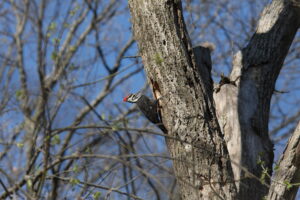
-
The Pileated woodpecker – Woody Woodpecker – is a sight to see!
-
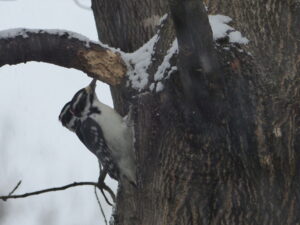
-
Woodpeckers dig for insects on trees.
-
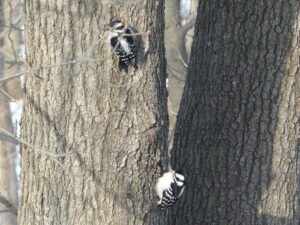
-
These woodpeckers are happy to forage for insects on a tree trunk.
Perhaps the best strategy for enjoying woodpeckers but preventing damage is to protect nearby dead trees. If a tree poses no falling threat to a structure, car, or person, leaving it in place gives woodpeckers a place to drum, nest, and find tasty insect meals.
Woodpeckers are amazing and beautiful animals that bring us joy. We are fortunate to have hairy, downy, red-bellied, red-headed, pileated, flicker, and sapsucker at Winding Pathways. They enjoy our feeders and leave the house alone.
-
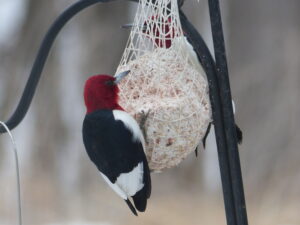
-
Woodpeckers would rather eat from a suet ball than drill on a house.
-
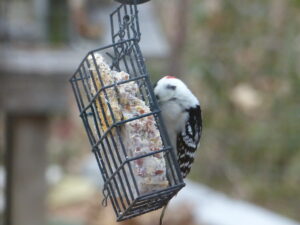
-
We’ve had all sorts of interesting woodpeckers at the feeders.
-
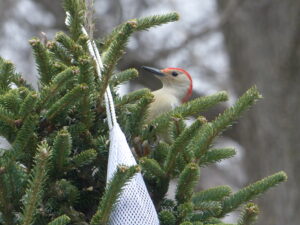
-
We tuck suet in Evergreen trees for the birds to enjoy.
by Winding Pathways | Oct 28, 2021 | (Sub)Urban Homesteading, Flowers/Grasses, Garden/Yard, Garden/Yard, Nature, Trees
A camera is an outstanding tool to see change. Plant a tree or prairie and it grows so glacially slowly that noting change is hard. Photos help by compressing time.
In August 2020 a derecho felled 47 of our 53 mature trees. We spent much of last fall converting them into firewood and piling up brush. Knowing that the land would be sunny after years of leafy shade, we planted a blend of savanna wildflowers last November.
The area didn’t change much from last fall until April of this year. Then nature put on a glorious show. Here are three photos of our yard taken in April, May, and September 2021. Most of the growth didn’t come from the seeds we planted last fall. Seeds long dormant in the soil sprouted with enthusiasm once they sensed the sun’s springtime warmth.
-
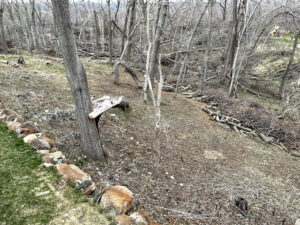
-
For over eight months the land lay waiting and still.
-
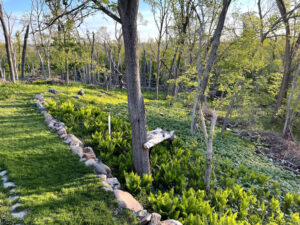
-
Ferns and Mayapple emerged strongly and yielded to more open woodland plants.
-
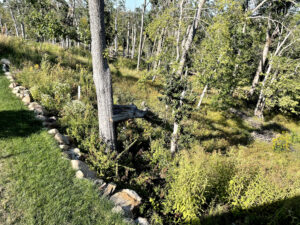
-
The seeds had waited dormant for the right conditions.
by Winding Pathways | Oct 14, 2021 | (Sub)Urban Homesteading, Chickens, Garden/Yard, Garden/Yard, Hoover's Hatchery, Nature
As we entered our driveway a frustrating sight greeted us. We were looking forward to picking the enormous seed heads of sunflower plants towering over the garden. Not this year. While we were gone, a windstorm toppled them a few weeks before they’d ripen.
That’s the way it is with gardening. Sometimes there’s a great success resulting in delicious meals. Then there are flops, like our sunflowers. We found more wind mischief. Several almost ripe pumpkins and squash had broken stems, dooming them to rot instead of ripening.
A Silver LIning
All wasn’t lost. We pitched the sunflower heads, pumpkins, and squash into our chicken run. Enthusiasm erupted as the hens eagerly devoured them. They pecked a hole in the squash and pumpkins, ate all their seeds, and then made quick work of eating the soft interior flesh. Soon all that remained was the tough outer skin of the pumpkin and the sunflower’s now seedless head. These went into the composter.
Chickens love garden debris and vegetables that don’t quite make it to our table. When fall closes down our garden we turn in the chickens. They chow down on bugs, weed seeds, and unripe vegetables. This makes clean-up easier and probably reduces next year’s insect and weed problems. A few days after Halloween our hens love snacking on our shriveling Jack O Lantern. They also relish seeds scooped out of winter squash and most vegetables left in the refrigerator a bit too long.
It was frustrating losing our sunflowers, pumpkins, and squash. Thanks to our industrious hens we were able to put them to good use.
-
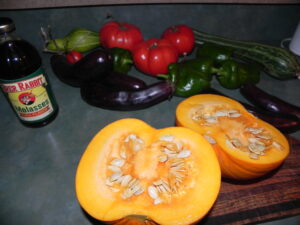
-
Seeds ready to eat.
-
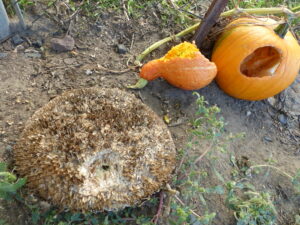
-
Holes pecked in pumpkin.
by Winding Pathways | Oct 7, 2021 | (Sub)Urban Homesteading, Chickens, Garden/Yard, Nature, Pests
There’s a Mouse in the House!
Sooner or later anyone who keeps a few chickens is likely to spot a mouse scurrying across the coop floor. Most sightings are after dark when hens are snoozing on their roosts. That’s when nocturnal mice seek a chicken feed dinner.
Commercial chicken feed is nutritious to more than chickens. Small rodents also thrive on it. They eat expensive feed and also foul it with their urine and droppings. Mice should be eliminated from the coop.
Two general types of mice can be found in places where both people and chickens live. European house mice are common all over the world. They usually spend their entire lives in a home or chicken house and rarely venture outdoors. These tiny rodents are dark gray all over. White-footed, or deer, mice are native rodents that commonly visit coops and the homes of the flock owner. They are easy to distinguish from house mice since, as their name implies, they have white feet and bellies.
While house mice live in a coop year round white-footed mice are more likely in cooler months. House mice usually eat food in place, while white footeds often carry seeds a distance and cache them in a hidden place to nibble on later. Find a pile of corn in an old boot or any other hidden place and the culprit is likely a white-footed mouse.
It’s not good to have either type of mouse mixing with chickens. Although it’s probably not possible to totally eliminate them, several actions greatly reduce their abundance.
The best strategy for reducing mouse infestations in either a house or chicken coop is to keep them out. Mice are tiny and athletic. They can squeeze through small holes and cracks, the same openings that let cold drafts enter. Keep both mice and cold air outside by filling in holes and cracks with caulking. The best time to do this is in early fall before cold weather settles in. Filling cracks also keeps box elder bugs, Asian beetles, and other insect pests outdoors. Cracks can be anywhere but are especially likely around window and door frames and where wires and pipes enter a structure.
Contain Food
Mice enter a chicken coop to find shelter from bad weather, safety from predators, and dinner. They love eating grain and chicken mash or pellets. Anything edible in the coop should be stored in metal containers with tight-fitting lids. Mice easily chew through plastic ones so avoid them. Use metal trash cans instead. Mice will help themselves to feed in a feeder, and most people leave feeders exposed at night. Since chickens don’t eat during dark hours put feeders in a tightly lidded metal garbage can overnight. This will keep mice away from them. The feeders can simply be put back where the chickens can access them the following morning.
Encourage Owls
A neighborhood owl family can be a chicken’s best friend. Owls love dining on mice. Great horned, barred, and screech owls are relatively common in suburban areas and patrol nighttime neighborhoods seeking small mammals to catch and eat. Owls are active when chickens are securely sleeping in the coop. This reduces the odds that a hen will end up an owl meal. According to Karla Bloem, Executive Director of the International Owl Center, owls can be a chicken keeper’s best friend.
Avoid Poison and Glue Boards
Although it’s tempting to use poison to rid a home or chicken coop of mice it should be avoided for these reasons:
- Poisoned mice might be eaten by chickens, non-targeted wildlife, and pets. They can be sickened or killed by residual poison in the mouse’s body.
- Poisoned mice sometimes die between walls or in inaccessible places. Soon their bodies smell terrible.
- Poison is slow acting and cruel. A quick death by a snapping trap is more humane.
- Chickens, children, pets, and nontarget wildlife might find and eat the poison.
Glue boards are pieces of cardboard or heavy paper covered with an extremely sticky substance. A mouse walking over a glue board will be held tightly. They can’t escape. While glue boards catch mice they also catch non-targeted animals. Any human who touches the sticky stuff will struggle to get free of it. Mice caught in glue boards usually starve to death or are found alive and struggling. It’s cruel.
Mice are relatively easy to trap using any of the many devices on the market. Most common are snap-type traps that have been effectively catching small rodents for over a century. For people who prefer not to touch a dead mouse, newer type traps enclose the entire body. Some traps are even electronic and electrocute the poor animal. There’s even a trap that will alert a cell phone when a mouse has been caught.
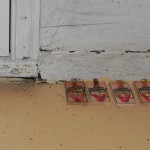
Place several traps side-by-side along a wall where you have seen evidence of mice.
Despite the fancy new type traps the old-fashioned kind, baited with peanut butter or soft cheese, is most common and least expensive. Traps should be set in places where chickens, pets, and children can’t access them. It’s best to set traps in the evening and either spring or retrieve them the next morning. Following are tips for increasing trapping success:
- Mice tend to run parallel to walls. Set traps next to walls with the trigger end closest to the wall. Traps with yellow plastic triggers that look like cheese may be slightly more effective than the older traps with metal triggers.
- Set traps in pairs or triplets. Put two or more traps side by side along the wall for the best odds of catching a fast-running mouse.
- Set out many traps. The best way to reduce mouse numbers is to catch all, or most, of the mice in the same evening.
- Don’t assume they’ve all been caught. Usually, there are many mice in a coop or home. Once most have been caught, keep setting them. Likely a few mice remain or new ones may enter.
Dispose of dead mice by flushing them down the toilet, putting them in the trash, burying them, or placing them in a woodsy or tall grassy area for scavengers to eat. Chickens will eat mice, also. Wash your hands well after touching the traps or mice.
Reducing mouse numbers in a coop is an important part of chicken husbandry. It takes some effort but preventing an infestation and trapping any that lurk in the coop is important.
*Reprinted with permission from Hoover’s Hatchery.
by Winding Pathways | Sep 30, 2021 | Garden/Yard, Nature, Pests
Poison ivy is a universally disliked and feared plant. It seems to grow everywhere. Encounter it and risk an itchy rash…..or worse. Some people are so sensitive to the oil on the leaf’s surface that they end up hospitalized.
Despite the discomfort it causes, poison ivy is an amazing native plant. It’s tough and thrives in any soil type, in drought or deluges. It loves living in the woods, at the edge of lawns and ballfields, and even in city vacant lots. It grows along ocean beaches and up mountains.
Scratching people may disagree, but there are two things to love about poison ivy. Both happen in the fall.
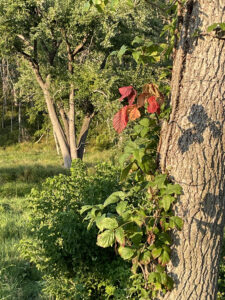
Keep your distance from this beguiling, colorful plant.
As days become cooler and daylight shortens poison ivy is one of the first plants to turn color. A month before sugar maples color up poison ivy leaves turn a glorious deep red. By late fall birds enjoy eating plentiful poison ivy berries. Apparently, they don’t get the itch and happily spread the common plant’s seeds when they poop them out.
There is one certain way to prevent a poison ivy itch. Enjoy it from a distance. Only contact with the plant’s oil can cause a rash. This can happen by touching the plant leaves or vines, patting an animal that has run through a poison ivy patch, accidentally touching clothes that have rubbed by poison ivy, or by breathing smoke with the oils in it when an area is being burned has poison ivy in it.















